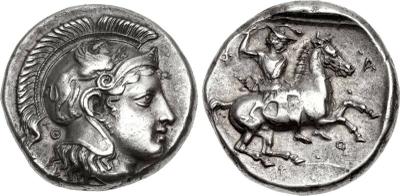3162 - Pharsalus (drachma Athena/horseman) over uncertain type (CNG, 26, June 1993, 278)
From SILVER
(CSV import-Overstrikes-2022-08-16) |
|||
| Line 1: | Line 1: | ||
{{Overstrike | {{Overstrike | ||
| − | |Sale=Classical Numismatic Group | + | |Image overstriking coin=Larissa_Athena_horseman.jpg |
| + | |Image reference overstriking coin=https://www.acsearch.info/search.html?id=1824990 | ||
| + | |Sale=Classical Numismatic Group, Triton XVII, 01 Jan. 2014, n°199 ; Classical Numismatic Group, 26, 11 June 1993, n°278; Classical Numismatic Auctions,11, 03 May 1990, n°55; Historical Coin Review, XIV/6, 11 Dec. 1989, n°30. | ||
|Private collection=R. A. J. Collection | |Private collection=R. A. J. Collection | ||
| − | |Obverse description=Head of Athena right, wearing crested Attic helmet, decorated with sphinx leaping right, and single-pendant earring. Behind neck guard, TΘ. | + | |Obverse description=Head of Athena right, wearing crested Attic helmet, decorated with sphinx leaping right, and single-pendant earring. Behind neck guard, TΘ. |
|Reverse legend=ΦΑΡΣ | |Reverse legend=ΦΑΡΣ | ||
| + | |Reverse legend language=Greek | ||
|Reverse description=Thessalian horseman charging right, wearing petasos, brandishing lagobolon. | |Reverse description=Thessalian horseman charging right, wearing petasos, brandishing lagobolon. | ||
|Mint=Pharsalus | |Mint=Pharsalus | ||
|Ancient region=Thessaly | |Ancient region=Thessaly | ||
| − | |Date from=400 | + | |Date from=400 BCE |
| − | |Date to=370 | + | |Date to=370 BCE |
|Period=Classic | |Period=Classic | ||
| + | |Metal=Silver | ||
|Weight=6.1 | |Weight=6.1 | ||
|Diameter=18 | |Diameter=18 | ||
| − | |Axis=8 | + | |Axis=8 |
| − | |Denomination= | + | |Denomination=drachma |
|Standard=Aeginetic | |Standard=Aeginetic | ||
| − | |Coin reference=Lavva | + | |Coin reference=Lavva 2001, n°144c corr. (V68/R84). |
| − | |Coin series reference= | + | |Coin series reference=HGC 4, n°626 |
| + | |Remarks="overstruck on uncertain type (portions visible on horse)" | ||
}} | }} | ||
Revision as of 11:44, 22 April 2024
400 BCE - 370 BCE | ΦΑΡΣ
Images
Overstriking coin

Larissa_Athena_horseman.jpg [1]
Location/history
| Sale(s)Sale(s) ᵖ: | Classical Numismatic Group, Triton XVII, 01 Jan. 2014, n°199 ; Classical Numismatic Group, 26, 11 June 1993, n°278; Classical Numismatic Auctions,11, 03 May 1990, n°55; Historical Coin Review, XIV/6, 11 Dec. 1989, n°30. | |
| Private collection(s)Private collection(s) ᵖ: | R. A. J. Collection |
Overstriking coin
Description
| ObverseInscription or printing placed on the obverse.: | Head of Athena right, wearing crested Attic helmet, decorated with sphinx leaping right, and single-pendant earring. Behind neck guard, TΘ. | ReverseInscription or printing placed on the reverse.: | ΦΑΡΣ (Greek) Thessalian horseman charging right, wearing petasos, brandishing lagobolon. |
Mint and issuing power
| MintIdentifies the place of manufacture or issue of a numismatic object.: | Pharsalus | Ancient regionAncient region. | Thessaly | Modern countryModern country: Greece | AuthorityIdentifies the issuing power. The authority can be "pretended" when the name or the portrait of X is on the coin but he/she was not the issuing power. It can also be "uncertain" when there is no mention of X on the coin but he/she was the issuing power according to the historical sources: |
Chronology
| FromIdentifies the initial date in a range assigned in a numismatic context. 400 BCE toIdentifies the final date in a range assigned in a numismatic context.. 370 BCE | Classic periodTime period of the numismatic object. |
Physical description
| MetalThe physical material (usually metal) from which an object is made.: Silver |
WeightWeight of the numismatic object (in grams). in grams: 6.16.1 g <br />6,100 mg <br /> | DenominationTerm indicating the value of a numismatic object. Examples: tetradrachm, chalkous, denarius.: drachma |
AxisDescribes the directional relationship between the obverse and reverse of a numismatic object.: 88 mm <br />0.8 cm <br /> |
| DiameterDescribes diameter of an object (in mm).: 1818 mm <br />1.8 cm <br /> | StandardStandard.: Aeginetic | ||
References
| Coin referenceReference of the Coin: | Lavva 2001, n°144c corr. (V68/R84). | Coin series referenceReference to coin series study: | HGC 41HGC 4, n°626 |
Overstruck type
Description
| ObverseInscription or printing placed on the obverse.: | ReverseInscription or printing placed on the reverse.: |
Mint and issuing power
| MintIdentifies the place of manufacture or issue of a numismatic object. ᵖ: | Ancient regionAncient region. ᵖ | Modern countryModern country: | AuthorityIdentifies the authority in whose name (explicitly or implicitly) a numismatic object was issued. ᵖ: |
Chronology
| FromIdentifies the initial date in a range assigned in a numismatic context. toIdentifies the final date in a range assigned in a numismatic context.. | periodTime period of the numismatic object. |
Physical description
References
| Coin type referenceReference to coin series study ᵖ: |
Additional data
| Frequency of overstrikesFrequency of overstrikes: | Level of confidenceLevel of confidence of the identification: | ||
| RemarksRemarks: | "overstruck on uncertain type (portions visible on horse)" | ||
References
- ^ Hoover, Oliver D. (2014), Handbook of Greek Coinage Series 4. Northern and Central Greece : Achaia Phthiotis, Ainis, Magnesia, Malis, Oita, Perrhaibia, Thessaly, Akarnania, Aitolia, Lokris, Phokis, Boiotia, Euboia, Attica, Megaris and Corinthia, sixth to first centuries BC, Lancaster, lxxi, 563 p.